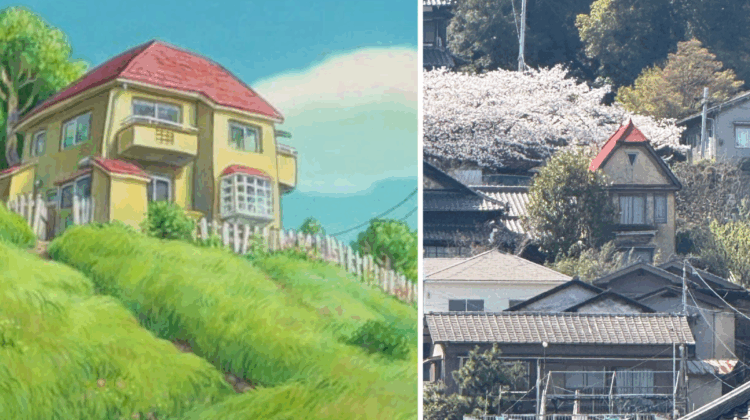
Ponyo-Tomonoura connection – the anime versus the real-life version of Susuke’s house.
Table of Contents
Ponyo is my all-time favourite Studio Ghibli/Hiyao Miyazaki film. Controversial, I know. Most adults tend to prefer Princess Mononoke or Spirited Away, but there is something about the pure innocence of Ponyo that gets me everytime. So today I’m taking a short break from my usual theatre reviews to focus on a travel feature, instead.
When I had a short stopover in Hiroshima, Japan I knew that I had to visit nearby Tomonoura, the tiny harbour town that inspired many of the scenes and locations in Ponyo. The town is a short Shinkansen trip and bus-ride away from Hiroshima Station, so I set off at 10am after a good breakfast and found myself pulling into Tomonoura about 1 hour and 20 minutes later.
I’m not gonna lie – I was not sure what to expect. This was not the same as visiting a filming location, where the route is immediately recognisable, and typically clearly marked. Tomonoura inspired scenes from Ponyo, but obviously the animation is not a carbon copy. Miyazaki’s genius imagination has done a lot of work here, too. So, my question was whether I would actually be able to recognize any of the spots or whether the relationship between Tomonoura and Ponyo is a distant one that requires a hefty dose of creative thinking.
The good news is that the locations that inspired Ponyo are obvious and most are easy to find, located within the heart of Tomonoura. I had no issues identifying any of them.
That said, Tomonoura is a stunning location in its own right, hailing back to the Edo period. It does not need the Ponyo connection to make it worth visiting. I found myself wandering off to enjoy other, unrelated aspects of town. This day trip was 100% a win-win all round.
Below, you’ll find a step-by-step guide to help you find all the Ponyo locations, but first some facts about Ponyo the movie itself.
About Studio Ghibli, Ponyo & Tomonoura – All You Need to Know
| Name | Ponyo on the Cliff by the Sea |
| Producer | Studio Ghibli |
| Director | Hiyao Miyazaki |
| Year of release | 2008 |
| Streaming on | Netflix, Prime Video |
Released in 2008, Ponyo is rarely cited as a favourite by fans of Studio Ghibli and Miyazaki. I’ve always felt that this was doing a disservice to the film. The plot line can be best described as a more innocent and wondrous The Little Mermaid, with a tinge of climate awareness.
Young Sosuke is playing in a cove in his hometown when, one find day, a little fish with the face of a human girl swims up to shore. She seems to be in trouble, so Sosuke rescues her and takes her back home in a small bucket. At one point, the little fish licks some blood off a cut on Sosuke’s finger, and her transformation into human-form begins. From there, it’s a whirlwind of adventure, as the old folk tales about what causes tsunamis in this little town collide with Sosuke’s burgeoning friendship with the little fish-turned-girl, whom he names Ponyo.
Miyazaki’s tale is superb, drawing from folk tales, horror, mythology and a ream of other source-material to create a completely original love story that defies the norms of gods and humans alike.
Step-by-step Guide to finding all Ponyo locations in Tomonoura
Step 1: You will reach Tomonoura by bus. Get off at the Tomonoura bus stop – don’t make the same mistake I did and wait until Tomo Port or you’ll just have to walk back to the tourist information centre just to pick up a free map. The map comes with two walking tour options depending on your energy levels, and adds a nice story-telling element explaining the different landmarks.
Back to the Tomonoura Ponyo locations. Leave the tourist centre behind you and walk in the direction of town. The 10 minute stroll gives you the opportunity to feast your eyes on the tapestry of islands dotting the inlet. Beyond that, a flotilla of stationery ships mark the horizon, exactly the same way they do in Ponyo.
Step 2: By now you’re at the mouth of the harbour. It’s very easy to let yourself be carried away by its sheer beauty and to start snapping photos haphazardly. But bear with me – instead, take a left away from the town centre.
Soak in the quaint fishing boats and the smiley old-timers going about their business. Then, keep walking past the breakwater and the large garage that’s right on the seafront, until you reach the steps at the back. At first I was worried this was a private area, but instead it took me to a gorgeous miniature shrine, complete with vermillion Tori gate leading to a small, sandy cove.
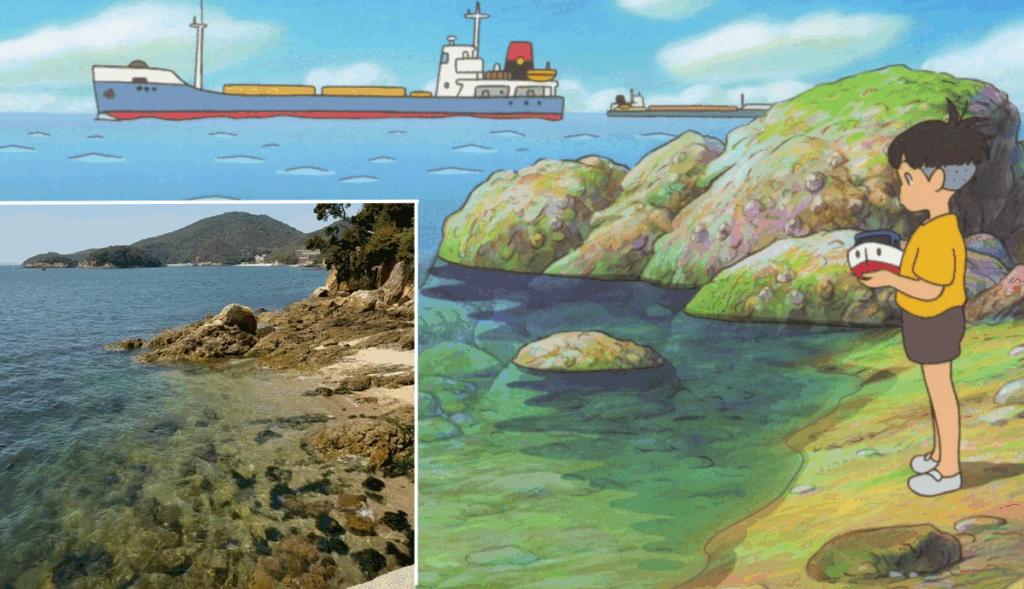
It doesn’t require a massive leap of imagination to make the connection- this is the cove that inspired Miyazaki’s drawings where Sosuke meets Ponyo for the first time, and the resemblance is pretty spot on.
Step 3: After you’ve had your fill, time to retrace your steps back to the mechanic’s. Take a detour through the narrow alley way to the left and keep walking until you reach the steps leading to Enpukuji Temple. Although smaller in scale, it is reminiscent of the old people’s home where Sosuke’s mother works. I could just picture the old ladies seated on their chairs overlooking the sea on the back terrace.
Step 4: Time to make your way back to the town centre. You’ll want to take your time here, enjoying the landscape without any stress. Maybe stop at Narutodo for a Tomonoura mochi – its bright blue hue symbolizes the sea, compounded by a hint of sea salt and the most luscious custard filling.
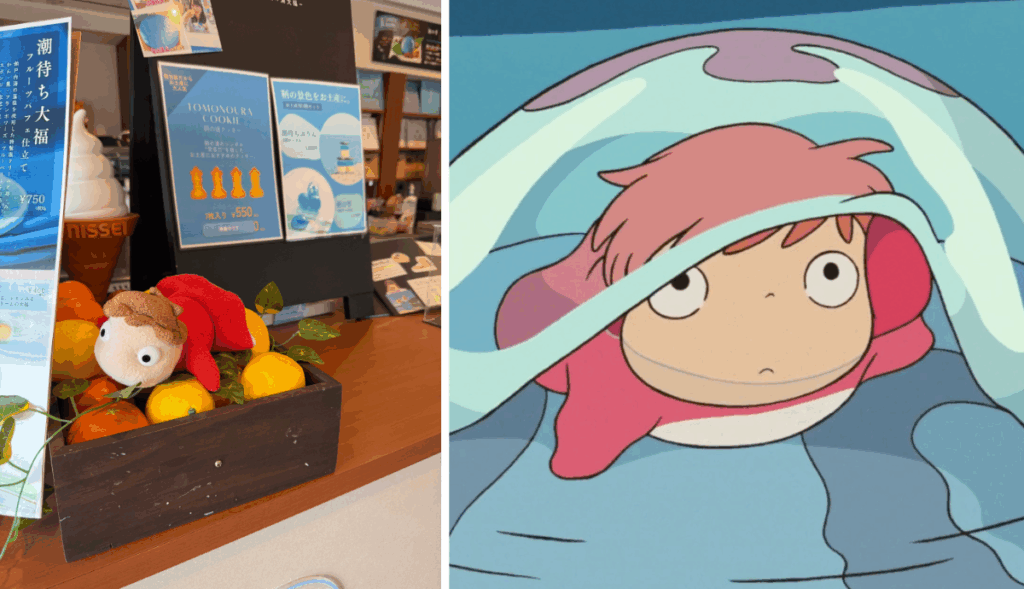
Step 5: From your vantage point sitting on the harbour steps enjoying your mochi, look up to the right towards the brightly painted houses that make up the town skyline. The deep blue of the thatched roofs make a pretty contrast to the bold vermillion – but one house in particular stands out more than the rest. Part of a cluster that is slightly higher up than the rest, its roof is painted a brighter red, the facade yellow, with a curiously-shaped window adorning the front. In truth, more of a port hole than a window.
This is the very house that inspired Sosuke’s home in Ponyo. In reality is is much smaller than it is in the film, and it’s not isolated at all, but again – the inspiration is unmistakable. You can get to it by following the narrow streets into town, but bear in mind that this is private property so it’s always good to take care not to disturb the residents.
Step 6: Keep following the promenade until you make it to the lighthouse. Here, you can bask in the Ponyo spirit while enjoying coffee and a snack. I was pleasantly surprised to find that, contrary to what I had been led to believe, the vast majority of shops accepted card payments.
Adjacent to the lighthouse there are plenty of souvenir shops to get a memento of the day. Again, I was surprised by how well the town has managed to preserve its authenticity. The shops are focused on regional specialties – such as Homeishu, a drink that’s reputed to have medicinal properties. No modern tat, here, thankfully.
Step 7: Once you’ve walked the length of the ‘shopping’ area you’ll notice that most tourists will have petered off. Continue walking along the seafront all the way into the residential zone. You’ll notice the road winding along the sandy coves and recognize it from this scene below.
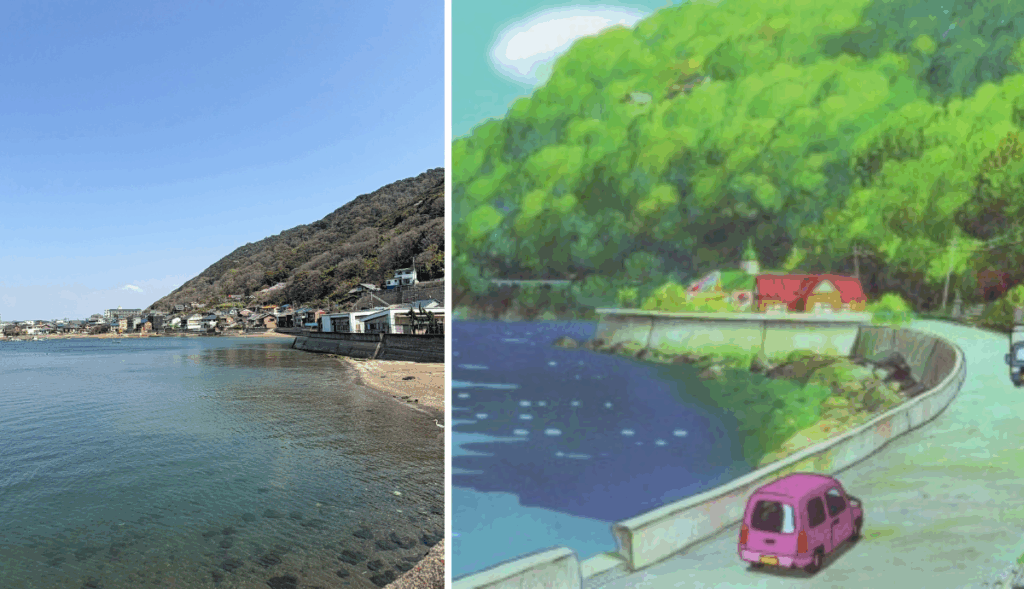
Do stop for a spot of seashell hunting. The beach is a treasure trove of fossilized shells and – for some strange reason – broken porcelain. There’s good potential to transform your finds into a souvenir necklace.
Step 8: Keep walking along the one main road until the houses start becoming more sparse. At a certain point you will come across a large Ponyo mural, with a playground right behind it. This is the school that inspired the school in the movie.
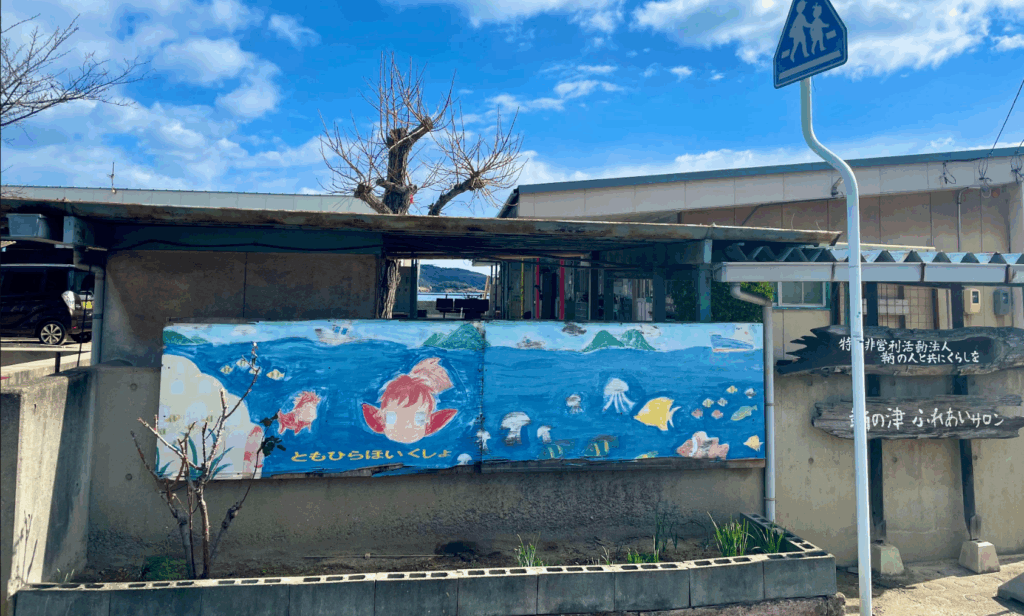
Step 9: Not strictly a Ponyo location but still worth the stop – Fukuzenji Temple. It’s quite a slog up the steep steps to the top but you will be rewarded with superb views spanning into the Harbour, all the way to Bentenjima and Sensuijima islands islands in the distance. If you wanted your IG reel worthy moment, you’ve got it.
This brought me to the end of my Ponyo trail and after I’d had my fill I made my way back for another matcha latte. There are two Ponyo landmarks that I missed. The first is the tunnel where Ponyo loses her human form. It was located too far for me to make it on foot.
The other is Sensuijima island, which inspires some of the scenes towards the end of the film, after the tsunami, when Ponyo and Sotsume are on the boat. If you have the time, it’s easily reachable by taking a five-minute ferry ride from the port.
I hope you enjoy hunting for the Tomonoura locations that inspired Ponyo as much as I did. As I already said, you don’t need to be a Miyazaki fan to find this town super charming. Having survived the madness of Kyoto a few days earlier, I was very appreciative of the natural beauty that has been allowed to shine in the friendly village.
I left Kyoto – as gorgeous as it is – feeling as though I had been to a theme park. But I left Tomonoura energized and grateful for having been allowed to experience the beauty of this place. Maybe as tourists we do need to make an effort to go beyond the obvious stops.
Top Tip to Help you find all Ponyo Locations
If you’re feeling sociable, let the attendant at the tourist information centre know that you’re on a Ponyo walking trail and they will be super happy to explain exactly how to get to each specific location, adding some heartwarming colour without overdoing it.
On that note, this is one of the things that make Tomonoura Port such a joy to explore – it remains unspoilt by over-tourism .While residents are justifiably proud of the Ponyo connection, they haven’t milked it to a theme park degree. You will find a couple of Ponyo murals and some souvenirs at the tourist centre, but that’s about it. Which means you can enjoy the unadulterated magic of the place.
Getting to Tomonoura
I reached Tomonoura from Hiroshima Station. Here’s what to do:
- Book the Shinkansen to Fukuyama Station
- Walk out to the bus terminus right outside the station
- Wait at Bus Bay No. 5 – buses run every 30 minutes
- Get off at a stop before reaching Tomo Port and cross the road to the tourist info station
- Get ready to walk!
So is a day-trip to Tomonoura Worth It?
Undoubtedly, yes. You don’t need to be a fan of Miyazaki or Ponyo to enjoy this as the town is gorgeous and you’ll find plenty of excellent food, souvenirs and breathtaking views. It only took me about an hour to reach it from Hiroshima, so you don’t even need to leave your hotel too early. I caught the 10.30 Shinkansen and enjoyed a few hours meandering town before making it back to my hotel in Hiroshima by 5pm.
Affiliate/Advertising Disclaimer
I received no payment for this travel feature and the opinions expressed here are purely my own. There are no affiliate links contained within this page.To learn more about my policies and my reviewing process, visit my Affiliate/Advertising disclosure page.
Are you enjoying my content? I usually publish culture-related content such as this theatre review of Blanket Ban, and this Teatru Malta 1881 review. You will also find lifestyle, fashion, and restaurants on this site.
